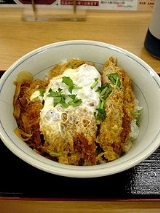
Katsudon
Encyclopedia
A katsudon is a popular Japanese food, a bowl of rice topped with a deep-fried pork cutlet
, egg, and condiments. Variations include sauce katsudon (with Worcestershire sauce
), demi katsudon (with demi-glace
and often green peas, a specialty of Okayama
), shio katsudon (with salt, another Okayama variety), shōyu-dare katsudon (with soy sauce
, Niigata
style), and miso
katsudon (a favorite in Nagoya
). Beef and chicken can substitute for the pork.
The dish takes its name from the Japanese words tonkatsu
(for pork cutlet) and donburi
(for rice bowl dish).
It has become a modern ritual
tradition
for Japanese students to eat katsudon the night before taking a major test or school entrance exam. This is because "katsu" is a homophone
of the verb 勝つ katsu, meaning "to win" or "to be victorious".
Tonkatsu
Tonkatsu , invented in the late 19th century, is a popular dish in Japan. It consists of a breaded, deep-fried pork cutlet one to two centimeters thick and sliced into bite-sized pieces, generally served with shredded cabbage and/or miso soup...
, egg, and condiments. Variations include sauce katsudon (with Worcestershire sauce
Worcestershire sauce
Worcestershire sauce , or Worcester sauce is a fermented liquid condiment; primarily used to flavour meat or fish dishes.First made at 60 Broad Street, Worcester, England, by two dispensing chemists, John Wheeley Lea and William Henry Perrins, the Lea & Perrins brand was commercialised in 1837 and...
), demi katsudon (with demi-glace
Demi-glace
Demi-glace is a rich brown sauce in French cuisine used by itself or as a base for other sauces. The term comes from the French word glace, which used in reference to a sauce means icing or glaze...
and often green peas, a specialty of Okayama
Okayama, Okayama
is the capital city of Okayama Prefecture in the Chūgoku region of Japan.The city was founded on June 1, 1889. As of August 2010, the city has an estimated population of 705,224 and a population density of 893 persons per km². The total area is 789.88 km²....
), shio katsudon (with salt, another Okayama variety), shōyu-dare katsudon (with soy sauce
Soy sauce
Soy sauce is a condiment produced by fermenting soybeans with Aspergillus oryzae or Aspergillus sojae molds, along with water and salt...
, Niigata
Niigata, Niigata
is the capital and the most populous city of Niigata Prefecture, Japan. It lies on the northwest coast of Honshu, the largest island of Japan, and faces the Sea of Japan and Sado Island....
style), and miso
Miso
is a traditional Japanese seasoning produced by fermenting rice, barley and/or soybeans, with salt and the fungus , the most typical miso being made with soy. The result is a thick paste used for sauces and spreads, pickling vegetables or meats, and mixing with dashi soup stock to serve as miso...
katsudon (a favorite in Nagoya
Nagoya, Aichi
is the third-largest incorporated city and the fourth most populous urban area in Japan.Located on the Pacific coast in the Chūbu region on central Honshu, it is the capital of Aichi Prefecture and is one of Japan's major ports along with those of Tokyo, Osaka, Kobe, Yokohama, Chiba, and Moji...
). Beef and chicken can substitute for the pork.
The dish takes its name from the Japanese words tonkatsu
Tonkatsu
Tonkatsu , invented in the late 19th century, is a popular dish in Japan. It consists of a breaded, deep-fried pork cutlet one to two centimeters thick and sliced into bite-sized pieces, generally served with shredded cabbage and/or miso soup...
(for pork cutlet) and donburi
Donburi
Donburi is a Japanese "rice bowl dish" consisting of fish, meat, vegetables or other ingredients simmered together and served over rice. Donburi meals are served in oversized rice bowls also called donburi...
(for rice bowl dish).
It has become a modern ritual
Ritual
A ritual is a set of actions, performed mainly for their symbolic value. It may be prescribed by a religion or by the traditions of a community. The term usually excludes actions which are arbitrarily chosen by the performers....
tradition
Tradition
A tradition is a ritual, belief or object passed down within a society, still maintained in the present, with origins in the past. Common examples include holidays or impractical but socially meaningful clothes , but the idea has also been applied to social norms such as greetings...
for Japanese students to eat katsudon the night before taking a major test or school entrance exam. This is because "katsu" is a homophone
Homophone
A homophone is a word that is pronounced the same as another word but differs in meaning. The words may be spelled the same, such as rose and rose , or differently, such as carat, caret, and carrot, or to, two, and too. Homophones that are spelled the same are also both homographs and homonyms...
of the verb 勝つ katsu, meaning "to win" or "to be victorious".

